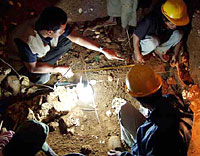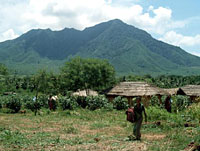


Jared Diamond talks about Homo floresiensis outside his office at UCLA. 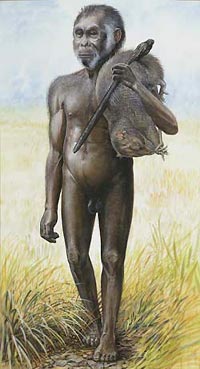
Did Homo floresiensis (above) coexist for any length of time with Homo sapiens? Later in this interview, Diamond explains why he feels it's highly improbable. 
The skinny island of Flores is part of a long chain of volcanic islands running through Indonesia, from Sumatra in the west to Timor in the east. 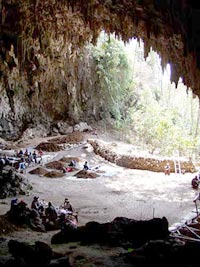
The remains of H. floresiensis were discovered inside this cave on Flores. 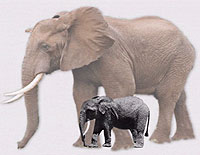
It's hard to imagine full-grown elephants as small as cows, but such pygmy pachyderms thrived on a number of small islands, including Flores. 
Without a periodic influx of new people arriving from elsewhere, Pitcairn Island proved too small to support its modest human population in ancient times. 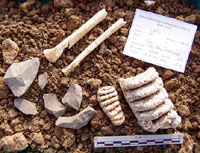
Some of the bones and artifacts associated with the hobbits that were found in Liang Bua cave on Flores 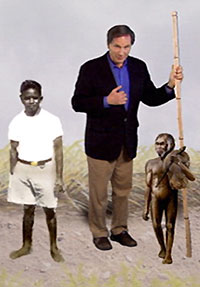
In the NOVA scienceNOW segment, host Robert Krulwich towers over an adult African Pygmy (in white shirt) and an adult H. floresiensis. 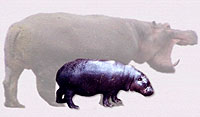
Diamond agrees that the shrinking of humans, like that of hippos that shrank on Cyprus, is "a spectacular solution" to the problem of limited resources on small islands. 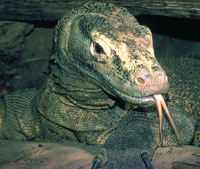
"Komodo dragons do not brush their teeth," Diamond notes, by way of saying that their mouths harbor a suite of deadly germs. 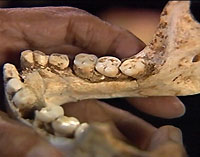
Komodo dragons may have been in the diet of the little people of Flores. (A little person's jawbone is shown here.) But if so, how did they hunt such formidable creatures? 

Casts of the cranial cavities of H. floresiensis (top) and H. sapiens show how much smaller the little peoples' brains were compared to ours. To see these endocasts in the full round, along with a chimpanzee's, see Compare the Brains. 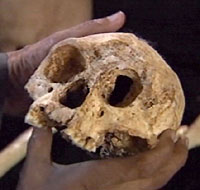
Did the little people of Flores have language? No one knows. 
There's good reason, Diamond says, why humans don't have sex with their closest genetic cousin, the chimpanzee. |
Jared Diamond, the noted evolutionary biologist and Pulitzer Prize-winning author of Guns, Germs, and Steel and most recently Collapse, has very definite ideas about why the little people of Flores would not have had sex with modern humans, would not have coexisted long with them in any case, and cannot possibly still survive today—among other cogent thoughts. In this wide-ranging interview, Robert Krulwich picks Diamond's spirited brain about all things floresiensis. Big story about little peopleKrulwich: Alright. First let me just ask you, as stories go, to me this is a big one. But what about to you? Diamond: To me, when I heard of this, I immediately said to myself, this is the most amazing discovery in any field of science in at least the last 10 years. Krulwich: That big? Diamond: Yeah. Krulwich: Why? Diamond: Why? Because it's the most drastically different human that existed in the last million years. And that it turned up—you wouldn't have thought that remarkable new discoveries like this were still waiting to be made among humans. And if made anywhere, I wouldn't have expected it to turn up on the island of Flores, which lots of zoologists have gone to to study Komodo dragons. You wouldn't expect something weird to be lurking there with all the searches for the Komodo dragon. Krulwich: Is the main weird thing that this is an ancient bit of life that is extremely modern all of a sudden? Or is it that there's just another bit of life that you didn't know about? Or both? Diamond: There are two weird things about it. One is that it's so small, smaller than any human or protohuman of the last five million years. And the other thing is that it appears to be a really late survivor of Homo erectus, which we thought was gone long before that. The third amazing thing is that there's the possibility that it coexisted with modern Homo sapiens, which would astonish me—and which I think is probably wrong. But it's open for discussion. Krulwich: If you were to just play a hunch—because, I mean, there are going to be arguments that say nay and there are going to be arguments that say yeah—is your hunch at this point that they actually existed as a separate species? Or that they were a sick bunch of human beings? Diamond: Well, I would bet $10, or 10 to one odds, that they were a separate species and not some deformed, microcephalic [that is, having an abnormally small head] modern humans. Krulwich: Why? Because you want it? Because it's a great tale? Or because there's just something in you that says, yeah, the data will deliver? Diamond: The data already out there—well, the skull does not resemble that of known microcephalics. They've got eight different specimens, or fragments of eight different specimens. The recent information on the brain indicates a very distinctive form of brain. The whole form of the skull is erectus-like, and it's not pathological-sapiens-like. So everything says yes erectus and no, not a weird sapiens. Island hoppingKrulwich: Alright. So puzzle number one: This is a creature that came out of Africa, like presumably all of us did, and kind of wandered into Europe and wandered into Asia. And now we find a variation on this creature on an island. Are you puzzled about how a creature like this would get to an island? Diamond: I'm puzzled, but not very puzzled. One may ask how on Earth did these very primitive humans get to an island? Getting to an island requires boats, and they probably didn't have the brains to have boats. But then reflect: On this island were also elephants that certainly did not have boats. And on another island in the same general area were not only a couple of types of elephants but also buffalo and pigs and at least two species of monkeys. And you can be sure that the buffalo and the monkeys did not have boats or rafts. So whatever way that the buffalo, elephants, pigs, and monkeys got there, humans got there. In fact, we know something about how animals reach islands. One way is they can swim. Elephants can swim reasonably well. Pigs likewise. Certainly humans can swim. The distances involved were slight. Krulwich: Like six or eight or 10 miles? Thirty miles? Something like that? Diamond: I think more like three to 10 miles. The water gaps even today are less than 30 miles. But all this was going on during the Ice Ages, when around the world a lot of water was locked up in glaciers. So sea level was low. And where at present you have shallow seas, up to 10,000 years ago would have been dry land. Like the English Channel used to be dry land. Krulwich: Oh, so you could have walked there conceivably? Diamond: No, you couldn't walk there. These particular channels were never obliterated, as the English Channel was. But they were considerably narrower than they are now. Krulwich: So if you walked most of the distance from Africa to near Flores, and you had a little bit of water between you and it, how would you get across that little bit of water? Not a raft, not a boat, because we're thinking they're too dumb for this? Diamond: Well, there were actually three possible ways. One is, maybe they did have enough brains to have a really primitive raft. For example, maybe they just had bamboo that they lashed together, and it may not take much brains to lash bamboo together. So that's one possibility. Another possibility is they swam—it's a few miles—or they got carried along by the current. Elephants did it, monkeys did it. If monkeys could do it, why couldn't these dumb humans do it? And then thirdly... Krulwich: You mean, you like grab onto a log and float for the afternoon or something like that? Diamond: Even without grabbing onto a log. Just floating. And the third possibility is what you say, that they grab onto a log. But it's bigger than a log. When you're on the coast in low tropical rainforest areas, when there's a big storm, whole pieces of bank get displaced and washed down rivers. Those pieces of bank actually have trees on them; they're like floating islands. That's the way that, for example, lots of rats and lizards reach islands. They get carried out on these big masses of floating vegetation. So I'd say there are three choices. It's these natural rafts, or they swam or floated, or they had just enough brains to build really simple bamboo rafts. Shrunk to fitKrulwich: Okay. Now, when these creatures arrive on the island, they are normal-sized. When we discover them later, they are smaller. What happened? Diamond: What happened? They shrunk in size. There are lots of precedents for that. There were lots of big animals that arrived on small islands and then, over evolutionary time, they shrunk in size. Krulwich: Such as? Diamond: There are lots of elephants, for example. Here where we sit in southern California, about 50 miles off the coast is an island called Santa Rosa that had pygmy mammoths. These were big mammoths that swam out there and ended up shrunk to horse size. There were pygmy elephants on lots of islands around the world. Krulwich: Is a pygmy elephant like 20 percent or 80 percent of the other, regular elephant? How shrinky are those? Diamond: Oh, they can be one tenth the mass. They can be cow-sized elephants. For example, on this very island with pygmy humans, Flores, there were pygmy elephants. So that's one pygmy. There were pygmy buffaloes. There were pygmy deer on quite a few islands. There were pygmy elk. There were pygmy giant deer. There were pygmy hippopotamuses in the Mediterranean. Krulwich: Oh, so getting smaller is kind of normal if you're isolated on an island? Diamond: If you're a big animal that gets isolated on an island, the only way to survive is to get smaller. If you don't get smaller, you die out. Krulwich: Why? Diamond: Because if you're big, the smaller island isn't able to hold enough individuals to make a sustainable population. For example, let's take humans. Suppose these were full-sized humans arriving on that island. Flores is a moderately small island. It might have been big enough to hold, in isolation, say 200 full-sized humans. Of those 200, 100 are males, 100 females. Of the 100 females, 50 are juveniles, and 50 are adults. And of those 50 adults, some are better than others. So what sounds like 200, a viable population, you end up with maybe only 10 or 20 skilled, reproductive females. That gets marginal. And then if you have a drought and a Komodo dragon kills a few of them on top of it, it's just not a viable population. You also get genetic problems—inbreeding—when you've got as few as 200. Now, suppose your humans are not 150-pound humans but 30-pound humans. You can get five times as many of them. And your population is not 200, but 1,000. Now you've got something viable. Krulwich: So you don't run the risk of everyone being first cousins of everybody else, resulting in a weak genetic situation? If you have more folks, then you have more variation, and you can be a little bit more robust? Diamond: It's not just that you have more variation. You've got more individuals. Few individuals, even if they've got great variation, are at risk of a fluctuation that wipes them out. So that's the reason why we've got on islands around the world all of these—there must be a couple of dozen populations of pygmy elephants and pygmy hippos and pygmy deer and pygmy giant deer and pygmy people. Krulwich: But one could argue that human beings are different from deer and buffalo and elephants, because they can have meetings, you know, maybe hand signals or something to say "Let's not have as many babies this year" or whatever. They don't have to do it inside their bodies. They can do it with their brains. Diamond: Brains are good for solving some problems, and they're not good for solving other problems. If the basic problem is that you don't have enough people, then no matter how smart you are, the population will die out. We have examples of this in modern times. There are modern human populations that were too small and died out. For example, Pitcairn Island, which was colonized by the Bounty mutineers because it was supposedly an empty island. When the Bounty mutineers arrived on Pitcairn in 1790, they found abandoned temple platforms and statues. There had been a human population isolated there. From the size of Pitcairn, we can be confident that there were fewer than 200 individuals. They were able to survive as long as there were boats bringing fresh humans. But once the boats disappeared, that population then died out. So we know that not even modern humans are enough to survive as a small population. Krulwich: So it's crucial to have as many of you as possible. On the other hand, you have to eat and take care of yourself. And that's the tension? Diamond: That's right. Krulwich: So smaller is better? Diamond: That's right. Krulwich: Why does this process begin on islands? What is it about islands that triggers this? Diamond: Restricted space, and hence a restricted population. This dwarfing occurs only on smallish islands. Dwarfing has not been documented for a big island like Japan or Britain. Krulwich: Is it also important that bigger, full-sized adult human beings don't join you from elsewhere periodically? I would think that's the other issue. You don't get any more biggies. Diamond: Yeah. If you had biggies, the biggies would provide genes. Krulwich: They would have sex with you, and you would have big babies? Diamond: You have sex and you have big babies. But the other thing is if you have biggies, the biggies will rescue the population. So say every generation in come a few individuals. Your population starts to get dangerously small, but then in come a few biggies, and they rescue the population. Krulwich: So you're not surprised, then, that this group of human types could become very small? Diamond: I would say yes and no. On thinking about it, I'm not surprised. The reason that I was surprised initially was that there hadn't been a documented case of dwarfing in island human populations. In retrospect, you could say "Okay, so there's dwarfing in humans. We already had dwarfing in elephants. What's the big deal?" But it was the first. A spectacular solutionKrulwich: Now, I want to talk about just how small. This is pretty small, as currently gauged. It's like three feet tall. It's very close to—I don't know if you've seen the Austin Powers movies. There's this character who is a mad scientist, and he delights in creating an absolutely tiny version of himself. It's smaller than a dwarf; it's like a three-foot-tall version. He calls it Mini-Me. It seems like movie stuff. In this case, though, a third of standard human size seems very small because it means that everything is a third smaller, particularly the brain. Doesn't that give you pause, a brain that's a third the size of your own? Diamond: It's even worse than that. The estimates of weight are something like 30 pounds compared to modern-sized humans of 150 pounds. So they were about one-fifth of human size. Again, if you had told me some scientist has made this amazing discovery of a dwarf human population [and you had asked] how big do you think they were, I would have guessed 80 pounds. Isn't that incredible? So when I say this is the most amazing discovery in the past 10 years, I would never have dreamed that they could have shrunk down to 30 pounds. Krulwich: What's crucial here, the weight, the scale, or the brain? Or all of it? Diamond: The weight and the food requirements. What's required in order to subsist as a smaller population is lots of small individuals with small food requirements. The brain isn't the problem. The food consumption is the problem. Krulwich: But this is tremendously successful then. If you can get down to that scale, then you're really treading very lightly on the land. There can be more and more of you. Diamond: That's right. Krulwich: It's a very spectacular solution. Diamond: It is. It's a spectacular solution, like the pygmy hippos on the island of Cyprus. They were cute little things about so big [indicates size of a pig]. That's pretty dramatic. Krulwich: What about the brain, though? First of all, these creatures had tools, and they had fire. I know this is not exactly your field, but I'm just curious. Fire is a dangerous thing. Does cooking mean that you're a sophisticate? Diamond: Neanderthals are the first humans for whom there's clear evidence of the control of fire. That is to say, Neanderthal campsites regularly show evidence of hearths. So we know that Neanderthals had fire. Now, Neanderthals had full-size brains, but those brains clearly were not up to the brains of modern humans, because Neanderthals did not invent rapidly, and they didn't have much in the way of art. Fire impresses me a little, but not very much. Dragons in the diet?Krulwich: What about the fact, and I'll read you the diet, when they look, they find contemporaneous burnt, chewed, gnawed, or otherwise looking like foodish versions of fish, frogs, snakes, tortoises, birds, rodents, bats, stegodonts... What's a stegodont? Diamond: Stegodonts are the pygmy elephants. Krulwich: Alright. And Komodo dragons. Have you ever seen a Komodo dragon? Diamond: Yes. Closely. Krulwich: Very closely? Diamond: Mm-hmm. Krulwich: I'm looking at one now, in my mind. I don't know how much they weigh, but this one looks like it's 250 pounds or something. What do they weigh? Diamond: Up to 500 pounds. But it's worse than that because while the modern Komodo dragons weigh up to 500 pounds, the archeological excavations that produced the dwarves also produced evidence of a super-size Komodo dragon. Krulwich: Oh, so these dragons are getting smaller, too, over time? Diamond: No, the dragons are different. Warm-blooded animals shrink on islands. Cold-blooded animals often expand on islands, to fill the niche left by lions and tigers that could not get out there. Cold-blooded animals have lower food requirements, and so a cold-blooded animal requires as much food as a warm-blooded animal one-seventh of its size. Krulwich: Oh! So while the mammals are going down, the reptiles could be going up? Diamond: It happened there on Flores. Flores has the Komodo dragon, the world's biggest lizard today. But in the past apparently it had a super Komodo dragon. Krulwich: What's going on with the mouth of this beast? It's going [makes slurping sound], and there's all this stuff flying in the air. What is that? Diamond: It's very interesting. Komodo dragons, the way that they kill is they're ambush predators. They can run quickly for about 20 or 50 feet and they get exhausted. So they can't chase down a prey. In modern times, Komodo dragons have been hunting introduced goats or buffalo. They wait in ambush, and they race out, and they take a bite. Sometimes they pull the animal down, but sometimes they don't, and the buffalo staggers off. Within a day or two, the buffalo dies an agonizing death of infection within the territory of the Komodo dragon that brought it down. And the reason that the buffalo has died this agonizing death is that Komodo dragons do not brush their teeth. Krulwich: [laughs] Diamond: In fact, they have specialized in not brushing their teeth. Because they've got all this rotting meat between their teeth, their mouths harbor bacteria. And these aren't just the bacteria that you and I would have if we ate steaks and then did not brush our teeth for a week. Komodo dragons have evolved really nasty bacteria. So what happens is the buffalo has been bitten, it staggers off, the wound gets infected, the buffalo gets really sick, and then it falls down in the territory of the Komodo dragon that wounded it. Krulwich: So that spit is—that's poisonous spit? Diamond: It's not spit that contains cyanide. It's spit that contains bacteria like botulism bacteria and anthrax and other things that you would not want to get infected by. Krulwich: So if you wanted to eat one of these things, if that's in your diet, then you'd better come prepared with tools, with some kind of cooperation, because you're only three feet tall. Diamond: Mm-hmm. Krulwich: What do you think? Diamond: Well, if I were three feet tall and I were hunting a Komodo dragon, and I were not yet smart enough to have bows and arrows, which they didn't have for sure, I would vote for a spear. A spear that I could throw. Or a lance. We know that Neanderthals in Europe had spears, so maybe these creatures had spears. This is all assuming that they really hunted the Komodo dragons. Krulwich: Right. Diamond: Because there's the added question of who really killed the stuff? Was it the dwarves? Or was it the later sapiens? Krulwich: If they were eating them before the sapiens arrived, though, then it really gets interesting. Diamond: Yeah. Then they had to have some way of killing a Komodo dragon. And if I were to do it, I would elect for a thrown spear, so that I didn't have to get in close quarters. A question of brainsKrulwich: Would I be able to say "Hey, Charlie, move over to the left?" Or have some form of language? Diamond: Not necessarily, because wolves and lions do pretty good communal hunting without any form of language. Krulwich: So having Komodo dragon meat in my diet is not an absolute, not the Harvard Law degree of brains? I mean, it just means that you're a little ahead of the game, but you aren't a monster intelligence? Or does it? Diamond: Unless wolves and lions are graduating from Harvard Law School nowadays, which they certainly were not in my day. Krulwich: [laughs] Diamond: No, I would say hunting a Komodo dragon, that's not the real test of brains. Krulwich: Which leaves us with this other question of, when scientists have now begun looking at endocasts of these brains, they say—well, at least this fellow Ralph [Holloway, an anthropologist at Columbia University] who we talked to—he says, well, they don't look the same as human brains. There could be two reasons for that. They could be sick human brains, in which case they would look like sick human brains, or they could be something different. At the moment, as we're interviewing, the preponderance of view is that they seem to be something different. The question is, can you create a brain that can do more work in a smaller cavity? That's one of the big questions raised here. Diamond: Mm-hmm. Krulwich: What do you think? Diamond: Uh, I wouldn't reject the possibility. Here's a clear example of evolving a brain that can do far better in the same space, or even in less space: The brains of Neanderthals were, on average, slightly larger than the brains of modern humans. But modern humans were far more inventive than Neanderthals. As soon as you get modern humans—sapiens—you begin to get art, you begin to get rapid change of artifacts. You start getting bows and arrows, and spear throwers. You get far more rapid invention than had gone on with 300,000 years of Neanderthals. So the secret to modern humans was not getting a bigger brain. The brain is getting smaller. Something happened in the reorganization of the brain that made them smarter. Krulwich: But this is a pretty big challenge. We're talking here about one-third the size. Diamond: Mm-hmm. Krulwich: A little bigger than chimpanzees, a lot less big than, for example, you. Diamond: Mm-hmm. Krulwich: So you have to imagine a thinking, conscious, sentient person with a third of your brain. A third. Diamond: A somewhat thinking, somewhat conscious, somewhat sentient person. And without being boastful, I still believe that I would outclass them, and that all of us here would outclass them. They might have had enough brains to make tools, maybe even moderately sophisticated tools. How much brains does that require? People have tried to teach tool-making to chimpanzees. The problem is not so much with their brains as with their hand grip. These dwarves had a good hand grip—people have had a good hand grip for two million years. In truth, it remains to be seen how smart they were. I haven't seen evidence of proto-Einsteins out there yet. Unsafe sexKrulwich: Alright. Last set of questions. This has to do with sex mostly. We have this astonishing thought that on this island were two populations—for maybe as many as 40,000 years, Homo sapiens (us) and little people. Now, the eighth-grade definition of species is that if you're a little person and I'm a big person, I wouldn't want to have sex with you because you look "other," and if I did have sex with you, I/we couldn't have a baby. Is that where we are in this situation? Diamond: Uh, yes. The definition of species is reproductive isolation. Populations that don't interbreed with each other given the opportunity would be considered distinct species. So I guess the final question that everybody is too shy to ask about these micropygmies is, did we or didn't we have sex with them? Because the fact is that modern humans, Homo sapiens, eventually arrived at this island of Flores and would have coexisted for some length of time that you can argue about. Did we or didn't we have sex with them? My bet is we did not have sex with them, and here's my reasoning. Although they were small, they would have been tough, nasty characters. About a week and a half ago in Los Angeles, there was a really tragic, awful event in which a couple who had brought up a pet chimpanzee went and visited their pet chimpanzee in an animal shelter with a couple of other chimpanzees that had been kept there for a long time. These were chimpanzees habituated to humans. And something went wrong. Two teenage male chimpanzees attacked the man, and the result was just awful. They pulled off his nose, and [attacked] his eyes. They chewed off every one of his fingers. They chewed out his buttocks. Okay? What do I think would have happened if some full-sized male sapiens had presented his private parts for having sex with this 30-pound pygmy? I would not have given much for the future of the private parts of that male sapiens. Krulwich: Really? Diamond: I would predict that those pygmies would have been really nasty. Just like any humans would be really nasty. Krulwich: What, because the pygmy looking at the other was like "This is an other. I don't know why he's doing this to me?" Diamond: That's right. This would be hostile. Modern human populations are hostile to each other. It takes something to have sex between modern human populations. Krulwich: How about curiosity? I mean, we all know about folks who, you know, sometimes go off into the barn and do things we don't even need to know about. Couldn't there have been a little person and a big person who just wanted to "I'll show you mine if you show me yours" and it wouldn't have been quite such a hostile act? Wiped outDiamond: Almost all sheep are nice [laughs]. Almost all humans are not nice. Example: Today, in Africa, we have chimpanzees. Chimpanzees are about the same size as humans, and genetically they're the species closest to humans. Despite that, there is no attested case of humans having sex with chimpanzees. It would be absolutely lethal. The man who did it would come off without his private parts! Krulwich: Alright. So you're thinking here real speciation. If there were an attempt to inseminate one to the other, what would be the issue, if they were truly a different species? Diamond: The likelihood of a viable hybrid, given the extreme differences, would be rather slight. There are the size differences. One would expect there to be developmental differences, maybe a different duration of pregnancy. I would expect them to be too different. But on top of that, people talk about possible coexistence between the micropygmies and modern sapiens for 40,000 years. I don't believe it. My guess is that within 100 years of modern sapiens arriving on the island, the dwarves would have been exterminated. Krulwich: By the humans? Diamond: By the humans. We know that modern humans, given the opportunity, exterminate other modern humans. I cannot believe that they would have failed to exterminate these dwarves in a very short time. Krulwich: That seems to be your prejudice. I mean, you said the dumbest thing that ever happened was Carl Sagan sending off the message to outer space saying "Here we are, the lovely people on Earth." In your mind, that was called "Come and get me." Diamond: That's right. I've worked in New Guinea for the last 41 years, and I know what happens in New Guinea. And we have evidence about what happens in traditional human societies, namely, there are uneasy relationships at the boundaries. You certainly don't tolerate strangers, because it's dangerous to tolerate strangers. You try to kill them. When a human population colonizes an area with another human population, there is a touchy negotiation in which either one group exterminates the other or they decide that they can't exterminate the other, so they see if there is some mode of coexistence based on different economics. For example, coexistence between Pygmies and farmers in the Congo basin. Pygmies and farmers don't kill each other. They have different economies, which match. The Pygmies are hunter gatherers; they gather honey, they hunt animals in the jungle. And the farmers grow crops. So the Pygmies and the farmers trade back and forth. They have different economies. It works. In the case, then, of the micropygmies and Homo sapiens [on Flores], both of them would have been hunter gatherers. They would have been competing directly. There would have been no basis for trade, because there wouldn't have been a difference that would have allowed profitable trade. Krulwich: So this would be a case of "I'm here, and therefore you're not, because you're in my way." Diamond: "I'm here, and you're going to be good food, and this is my island." Again, I would bet 10 to one odds on my $10 that the micropygmies did not last. I would give them 100 years. Maybe even just 10 years from the time that full-sized sapiens arrived before they were exterminated. Krulwich: So you don't buy into this 40,000 years of cohabitation at all? Diamond: Absolutely not. Still with us?Krulwich: Let's finish, then, with this question. Is it possible, in this modern world, that these creatures might still be around? Diamond: No [laughs]. Krulwich: Not possible? Diamond: No. It's not possible because humans have been running around every place in the modern world. Why did they discover the micropygmies? Because their bones were buried deeply in the ground. Even archeologists working on the island of Flores came across the bones only relatively recently. There have not been surprising new human populations discovered except in previously unexplored areas like the New Guinea islands. Krulwich: What about folktales? I mean, Norwegians had elves, we have hobbits. Are those just stories people tell each other, or do they have any probative value to scientists? Diamond: Zero. Krulwich: Zero? Diamond: Zero [laughs]. Krulwich: What do you mean? If you arrive somewhere, don't the stories people tell, don't your ears perk up? Diamond: Yes, my ears [do], but people tell all sorts of strange stories, and some of them are true, and some of them are not true. We have to assess whether they might be true. Might it be the case that after thousands of years of Indonesians tramping around every single island in Indonesia, and after a couple of hundred years of Europeans tramping around Indonesia, and after 100 years of people tramping around the island of Flores 100 years after we discovered the Komodo dragon, might there still be tiny people out there in the jungle? No. No chance whatsoever. Krulwich: Alright. Then I'm going to ask you a stupid very last question. Let's suppose that you wanted to look for one anyway. Where would you look?
Diamond: In another galaxy [laughs]. Certainly not on Earth.
|
“If you’re a big animal that gets isolated on an island, the only way to survive is to get smaller.” “Brains are good for solving some problems, and they’re not good for solving other problems.” “Fire impresses me a little, but not very much.” “It remains to be seen how smart they were. I haven’t seen evidence of proto-Einsteins out there yet.” “You certainly don’t tolerate strangers, because it’s dangerous to tolerate strangers.” |
|||||||||
|
Interview conducted on March 14, 2005 outside Diamond's office at UCLA by Robert Krulwich, host of NOVA scienceNOW, and edited by Peter Tyson, editor in chief of NOVA online |
|||||||||||
|
© | Created April 2005 |
|||||||||||
